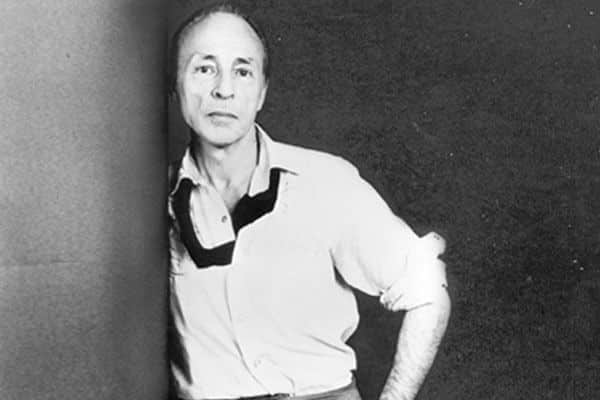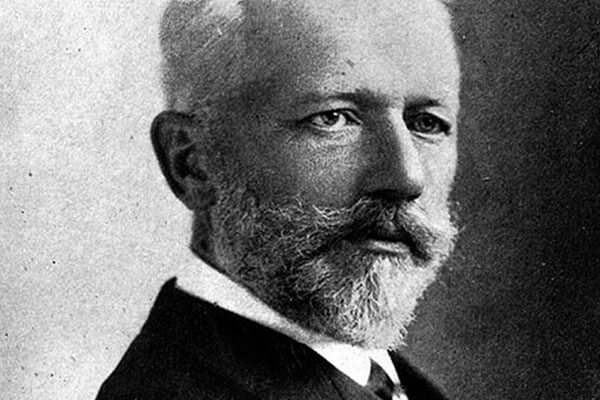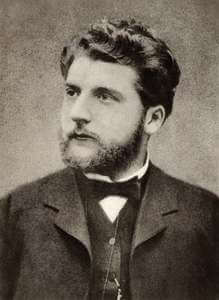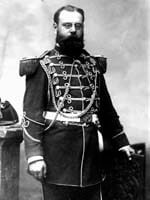
Born in St. Petersburg, Russia, George Balanchine (1904-1983) is regarded as the foremost contemporary choreographer in the world of ballet. He came to the United States in late 1933, at the age of 29, accepting the invitation of the young American arts patron Lincoln Kirstein (1907-96), whose great passions included the dream of creating a ballet company in America. At Balanchine’s behest, Kirstein was also prepared to support the formation of an American academy of ballet that would eventually rival the long-established schools of Europe.
This was the School of American Ballet, founded in 1934, the first product of the Balanchine-Kirstein collaboration. Several ballet companies directed by the two were created and dissolved in the years that followed, while Balanchine found other outlets for his choreography. Eventually, with a performance on October 11, 1948, the New York City Ballet was born. Balanchine served as its ballet master and principal choreographer from 1948 until his death in 1983.
Balanchine’s more than 400 dance works include Serenade (1934), Concerto Barocco(1941), Le Palais de Cristal, later renamed Symphony in C (1947), Orpheus (1948), The Nutcracker (1954), Agon (1957), Symphony in Three Movements (1972), Stravinsky Violin Concerto (1972), Vienna Waltzes (1977), Ballo della Regina (1978), and Mozartiana (1981). His final ballet, a new version of Stravinsky’s Variations for Orchestra, was created in 1982.
He also choreographed for films, operas, revues, and musicals. Among his best-known dances for the stage is Slaughter on Tenth Avenue, originally created for Broadway’s On Your Toes (1936). The musical was later made into a movie.
A major artistic figure of the twentieth century, Balanchine revolutionized the look of classical ballet. Taking classicism as his base, he heightened, quickened, expanded, streamlined, and even inverted the fundamentals of the 400-year-old language of academic dance. This had an inestimable influence on the growth of dance in America. Although at first his style seemed particularly suited to the energy and speed of American dancers, especially those he trained, his ballets are now performed by all the major classical ballet companies throughout the world.

Peter Ilyich Tchaikovsky, born in Kamsko Votkinsk in the district of Viatka on May 7, 1840, was the son of a mining engineer. Although he began piano instruction at the age of five and showed signs of musical precociousness, a musical career was not anticipated at that time. In 1850, he was enrolled in the preparatory class of the School of Jurisprudence when his family moved to St. Petersburg. He was admitted to the School of Jurisprudence in 1852, and while he was still a student there, he composed a canzonetta that became his first published work. In 1859, he completed his course of study and took a post as a clerk in the Ministry of Justice, but he continued to pursue musical studies, including voice, thorough bass and composition. He resigned from his post in l863 and became a full-time student at the St. Petersburg Conservatory, directed by Anton Rubinstein. It was during this period that he made his debut as a conductor and composed The Storm, his only student composition to be heard with any frequency today. In it, he already exhibited stylistic elements prominent in his later works, including the influence of Russian folk-melody, a command of Western compositional techniques and a flair for brilliant orchestration. Even before his graduation in 1865, he was offered a position as teacher of harmony at what was to become the Moscow Conservatory.
In 1866, he moved to Moscow. There he came under the influence of Anton’s brother Nikolai Rubinstein and met Peter Jurgenson, who would eventually become his publisher. His First Symphony, begun in 1866, proved to be a difficult and laborious exercise for Tchaikovsky, who found the structural demands of the symphonic sonata form incompatible with his own style. It was not performed until 1869, but it was well received. His began first opera, Voyevoda, in 1867, the year in which he met Berlioz and Balakirev, leader of the nationalistic movement in Russian music. Balakirev conducted the first St. Petersburg performance of Tchaikovsky‚ symphonic fantasia Fatum, composed in 1868. Tchaikovsky later destroyed the work, as he would several others, but it was eventually reconstructed. Balakirev’s influence was also felt in Tchaikovsky‚Äôs first masterpiece, Romeo and Juliet, which he rewrote several times at Balakirev‚ suggestion. From 1870 to 1874, Tchaikovsky became increasingly interested in nationalistic music, although his conservatory training and familiarity with Western techniques kept him outside the circle of ‚ÄúThe Mighty Five‚Äù (Balakirev, Cui, Borodin, Mussorgsky and Rimsky-Korsakov). His nationalistic tendencies came to a peak with the opera Vakula the Smith, first staged in 1876, by which time his infatuation with nationalism in music had declined. He wrote his first music for solo instrument and orchestra from 1874 to 1877, including his celebrated First Piano Concerto (1875), and in 1875‚Äì76 composed his first ballet, Swan Lake. The first performance in 1877 was considered a failure, based less upon Tchaikovsky’s score (which was severely cut and further compromised with interpolations by other composers) than by a poor performance and mediocre physical production. Swan Lake was later revived with new choreography by Petipa and Ivanov in 1895, at which time it was recognized as a masterpiece of the ballet repertoire. Around the end of 1876, Tchaikovsky began to receive financial support from a wealthy widow, Nadezhda von Meck, who was to remain his devoted patroness for the next 14 years. With a new found financial security, Tchaikovsky embarked upon a period of incredible musical fecundity, producing such cornerstones of the international repertoire as his Fourth Symphony, the violin concerto and the opera Eugene Onegin. Most of his compositions from the years 1878‚Äì84 have not proved as enduring, although his stature in Russia continued to grow, as exemplified by two events in 1884: his opera Mazeppa was given concurrent productions in St. Petersburg and Mosocw and he was awarded the Order of St. Vladimir by the Tsar. In 1887, Tchaikovsky undertook his first foreign tour as a conductor, during which he met such notables as Brahms and Grieg. It was almost immediately after composing his Fifth Symphony in 1888 that he began work on his second ballet, The Sleeping Beauty. The work was given an elaborate premiere and was well received, but the public reaction did not meet the expectations of the composer, choreographer (Petipa) and designer-impresario (Vsevolozhsky), and it was to be some years before the work was recognized as one of the pinnacles of classical ballet. Tchaikovsky went on without pause to compose the opera The Queen of Spades, which received a successful premiere in 1890 and, along with Eugene Onegin, became an international repertory item. Its success brought about a commission from the Imperial Theatre for two one-act works, the opera Iolanta and the ballet The Nutcracker, one of his most enduringly popular works despite its disappointing reception at its 1892 premiere. Tchaikovsky‚Äôs Sixth Symphony, his most profoundly pessimistic work, was first performed October 28, 1893. Nine days later, he died. His death is universally considered to have been a suicide, but the circumstances leading to it have become a musicological controversy that is yet to be resolved. Once considered by his contemporaries to be too Western in his style, Tchaikovsky was later lionized by Igor Stravinsky as the most Russian of Russian composers. His greatest strength, his incomparable gift for melody, was also responsible for his difficulty in composing within the structures of the German school of composition, and his blatant emotionalism has alienated some commentators. Nonetheless, he is today one of the most popular of all composers, and he created masterpieces in every genre. His music seems uniquely suited to ballet, with its inexhaustible stream of melody, an instinctive sense of movement considered ideal for the human body, and an irresistible rhythmic pulse and brilliant orchestration. It is no coincidence that all three of his ballets are firmly entrenched in the international repertoire.

Georges Bizet was was registered with the legal name Alexandre-César-Léopold Bizet, but was baptized Georges Bizet and was always known by the latter name. He entered the Paris Conservatory of Music a fortnight before his tenth birthday.
Georges Bizet’s first symphony, the Symphony in C Major, was written there when he was seventeen, evidently as a student assignment. It seems that Bizet completely forgot about it himself, and it was not discovered again until 1935, in the archives of the Conservatory library. Upon its first performance, it was immediately hailed as a junior masterwork and a welcome addition to the early Romantic period repertoire. A delightful work (and a prodigious one, from a seventeen-year-old boy), the symphony is noteworthy for bearing an amazing stylistic resemblance to the music of Franz Schubert, whose work was virtually unknown in Paris at that time (with the possible exception of a few of his songs). A second symphony, Roma was not completed.
In 1857 a setting of the one-act operetta Le docteur Miracle won him a share in a prize offered by Jacques Offenbach. Georges Bizet also won the Music Composition scholarship of the Prix de Rome, the conditions of which required him to study in Rome for three years. There, his talent developed as he wrote such works as the opera Don Procopio. Apart from this period in Rome, Bizet lived in the Paris area all his life. His mother died shortly after his return to Paris. He composed the opera Les pêcheurs de perles (The Pearl Fishers) for the Theatre-Lyrique in 1863, which was an initial failure. He followed it with La jolie fille de Perth (1867), and Jeux d’enfants (Children’s games) for the piano.
The popular L’arlésienne were originally produced as incidental music for a play by Alphonse Daudet, first performed in 1872. Georges Bizet also composed a romantic opera, Djamileh, which is often seen as a precursor to Carmen, 1875. This latter opera is Bizet’s best-known work and is based on a novella of the same title written in 1846 by Prosper Mérimée. Bizet composed the title role for a mezzo-soprano. Carmen was not initially well-received but praise for it eventually came from well-known contemporaries including Claude Debussy, Camille Saint-Saëns and Pyotr Tchaikovsky. Their views proved to be prophetic, as Carmen has since become one of the most popular works in the entire operatic repertoire. However Bizet did not live to see its success, as he died from angina at the age of 36 a few months after its first few performances, on his third wedding anniversary. He was buried in the Père Lachaise Cemetery in Paris.
Georges Bizet’s music has been used in the 20th century as the basis for several important ballets. The Soviet-era Carmen Suite (1967), set to music drawn from Carmen arranged by Rodion Shchedrin, gave the Bolshoi ballerina Maya Plisetskaya one of her signature roles; it was choreographed by Alberto Alonso. In the West the L’Arlesienne of Roland Petit is well-regarded, and the Symphony in C by George Balanchine is considered to be one of the great ballets of the 20th century. It was first presented as Le Palais de Crystal by the Paris Opera Ballet in 1947, and has been in the repertory there ever since. The ballet has no story; it simply fits the music: each movement of the symphony has its own ballerina, cavalier, and Corps de Ballet, all of whom dance together in the finale.

Unequalled by his predecessors, John Philip Sousa is responsible for bringing the United States Marine Band to an unprecedented level of excellence: a standard upheld by every Marine Band Director since. Sousa grew up with the Marine Band, and his intimate knowledge of the band coupled with his great ability provided the ideal medium to showcase the marches which would earn him the title, the “March King.”
Sousa was born Nov. 6, 1854, at 636 G Street, SE, Washington, DC, near the Marine Barracks where his father, Antonio, was a musician in the Marine Band. He received his grammar school education in Washington and for several of his school years enrolled in a private conservatory of music operated by John Esputa, Jr. There he studied piano and most of the orchestral instruments, but his first love was the violin. John Philip Sousa gained great proficiency on the violin, and at the age of 13 he was almost persuaded to join a circus band. However, his father intervened and enlisted him as an apprentice musician in the Marine Band. Except for a period of six months, Sousa remained in the band until he was 20.
In addition to his musical training in the Marine Band, he studied music theory and composition with George Felix Benkert, a noted Washington orchestra leader and teacher.
After his discharge from the Marine Corps, Sousa remained in Washington for a time, conducting and playing the violin. He toured with several traveling theater orchestras and moved, in 1876, to Philadelphia. There he worked as a composer, arranger, and proofreader for publishing houses. Sousa was fascinated by the operetta form and toured with a company producing the musical Our Flirtation, for which he wrote the incidental music and the march. While on tour in St. Louis, he received a telegram offering him the leadership of the Marine Band in Washington. He accepted and reported for duty on Oct. 1, 1880, becoming the band’s 17th Leader.
The Marine Band was Sousa’s first experience conducting a military band, and he approached musical matters unlike most of his predecessors. He replaced much of the music in the library with symphonic transcriptions and changed the instrumentation to meet his needs. Rehearsals became exceptionally strict, and he shaped his musicians into the country’s premier military band. Marine Band concerts began to attract discriminating audiences, and the band’s reputation began to spread widely.
Sousa first received acclaim in military band circles with the writing of his march “The Gladiator” in 1886. From that time on he received ever-increasing attention and respect as a composer. In 1888, he wrote “Semper Fidelis.” Dedicated to “the officers and men of the Marine Corps,” it is traditionally known as the “official” march of the Marine Corps.
In 1889, Sousa wrote the “Washington Post” march to promote an essay contest sponsored by the newspaper; the march was soon adapted and identified with the new dance called the two-step. The “Washington Post” became the most popular tune in America and Europe, and critical response was overwhelming. A British band journalist remarked that since Johann Strauss, Jr., was called the “Waltz King” that American bandmaster Sousa should be called the “March King.” With this, Sousa’s regal title was coined and has remained ever since.
Under Sousa the Marine Band also made its first recordings. The phonograph was a relatively new invention, and the Columbia Phonograph Company sought an ensemble to record. The Marine Band was chosen, and 60 cylinders were released in the fall of 1890. By 1897, more than 400 different titles were available for sale, placing Sousa’s marches among the first and most popular pieces ever recorded, and the Marine Band one of the world’s first “recording stars.”
The immense popularity of the Marine Band made Sousa anxious to take his Marine Band on tour, and in 1891 President Benjamin Harrison gave official sanction for the first Marine Band tour, a tradition which has continued annually since that time, except in times of war.
After the second Marine Band tour in 1892, Sousa was approached by his manager, David Blakely, to organize his own civilian concert band, and on July 30 of that year, John Philip Sousa resigned as Director of the Marine Band. At his farewell concert on the White House lawn Sousa was presented with a handsome engraved baton by members of the Marine Band as a token of their respect and esteem. This baton was returned to the Marine Band by Sousa’s daughters, Jane Priscilla Sousa and Helen Sousa Abert, in 1953. The Sousa baton is now traditionally passed to the new Director of the Marine Band during change of command ceremonies.
In his 12 years as Leader of the Marine Band, he served under five Presidents, and the experience he gained with the Marine Band would be applied to his civilian band for the next 39 years. With his own band, Sousa’s fame and reputation would grow to even greater heights.
Sousa’s last appearance before “The President’s Own” was on the occasion of the Carabao Wallow of 1932 in Washington. Sousa, as a distinguished guest, rose from the speaker’s table, took the baton from Director Captain Taylor Branson, and led the orchestra through the stirring strains of “Hands Across the Sea .”
John Philip Sousa died on March 6, 1932, at Reading, Pa., where he was scheduled to conduct the Ringgold Band. His body was brought to his native Washington to lie in state in the Band Hall at Marine Barracks. Four days later, two companies of Marines and Sailors, the Marine Band, and honorary pall-bearers from the Army, Navy, and Marine Corps headed the funeral cortege from the Marine Barracks to Congressional Cemetery.
His music was not the only memorial to John Philip Sousa. In his native city on Dec. 9, 1939, the new Pennsylvania Avenue Bridge across the Anacostia River was dedicated to the memory of the great American composer and bandmaster. More recently, Sousa was enshrined in the Hall of Fame for Great Americans in a ceremony at the John F. Kennedy Center for the Performing Arts in 1976.
In a fitting tribute to its 17th Leader, in 1974 the Marine Band rededicated its historic band hall at Marine Barracks as “John Philip Sousa Band Hall.” The bell from the S.S. John Philip Sousa, a World War II Liberty ship, is there.
Perhaps the most significant tribute to Sousa’s influence on American culture, “The Stars and Stripes Forever” was designated as the national march of the United States on Dec. 11, 1987. A White House memorandum states the march has become “an integral part of the celebration of American life.”
In 2004, 26th Director Colonel Timothy W. Foley opened the season with a Sousa-style concert in honor of the Director’s sesquicentennial (150) year. This rousing performance has since become an annual tradition of opening each concert season in early January, and is reminiscent of Sousa and his sold-out concerts. On Nov. 6, 2004, “The March King’s” 150th birthday, “The President’s Own” and 33rd Commandant of the Marine Corps General Michael W. Hagee dedicated the new band hall at Marine Barracks Annex John Philip Sousa Hall.
“The President’s Own” concluded his sesquicentennial year on Nov. 5, 2005, by unveiling an eight-foot bronze statue of Sousa outside the band hall. The statue, funded by the Marine Corps Heritage Foundation, private donor Mickey Gordon, and the John Philip Sousa Foundation, is the only one of its kind. Sculpted by artist Terry Jones, the statue is an enduring testament to Sousa’s contributions to the Marine Band.